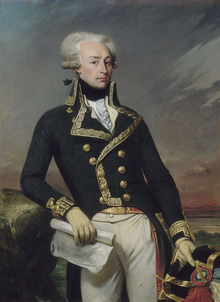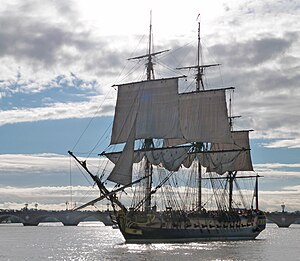One of the things I never understood was the viciousness of certain Americans when France refused to join President Bush’s war on terror 14 years ago.
Referring to the French as ‘cheese eating surrender monkeys’ — bouffes-fromage singes capitulaires — was beyond the pale, not to mention renaming French fries as ‘freedom fries’.
If it weren’t for French help during the Revolutionary War, American independence might not have been sustainable.
France spent much more than it gained by helping American patriots. In fact, the country’s national debt ballooned, a situation which eventually contributed to open, bloody revolt — the French Revolution. America pledged future trade with France, but, out of necessity, reneged by 1793 and remained neutral in future conflicts between Britain and France.
France’s motivations for involving themselves in the fate of the former British colonies were to avenge Great Britain’s victory in the Seven Years War and to help America’s Founding Fathers whose brilliance they greatly admired. It could be argued that France and America defined the Enlightenment.
On a practical level, King Louis XVI was concerned that Britain might make certain concessions to the former colonies and that, together, both might unite against French territories in the West Indies. Prior to 1778, the king discouraged his military men from actively helping the Americans. However, the Treaty of Alliance signed that year between France and the United States committed both to achieving America’s full independence, nothing less.
General Lafayette and the French touch
Prior to 1776, the French had been watching American colonists’ independence movement with great interest. They saw it as the perfect embodiment of Enlightenment ideals. A group of French agents began covertly shipping gunpowder to the patriots months before the colonists declared their independence. After the Declaration of Independence was signed, Benjamin Franklin sailed to France in December 1776. He was the toast of Paris, well received wherever he went. Thomas Jefferson was also enthusiastically welcomed on his visits.
By 1777, France was shipping more arms and men to America, although not with the official permission of Louis XVI. The Duc de Choiseul enlisted Frenchmen for army and navy reinforcements. Pierre Charles l’Enfant sailed to the United States to fight with the patriots.

Sail Training’s brochure on Lafayette and the reconstructed ship L’Hermione — more about which below — tells us (p. 5):
– Lafayette said of his participation in the American cause: ‘Why not?’ His can-do spirit prompted Americans of the day to call him ‘our Marquis’.
– During his service with George Washington, Lafayette became a trusted, loyal friend of the future first President. He served with distinction, including at the Battle of Brandywine.
– Once he returned to France to recover from war wounds, Lafayette further rallied the French to the patriots’ cause. It was his influence that encouraged Louis XVI to approve France’s formal involvement in the Revolutionary War and recognise the young Marquis as one of Washington’s generals.
L’Hermione and Lafayette’s return
In 1780, Lafayette sailed back to the United States on a new lightweight frigate, L’Hermione.
Lafayette said the ship ‘sailed like a bird’. Less relaxed, no doubt, was the commander, Louis-René de Latouche. Although Latouche was 13 years older than Lafayette, he was already awestruck by the young general’s reputation at home and abroad. He was also very concerned that Lafayette arrive safely in Boston. Describing the journey as ‘agréable‘, he later returned to France where he led a distinguished naval career.
L’Hermione’s arrival in Boston Harbor on April 28, 1780, was met with a 13-gun salute. Lafayette sent word to Washington: ‘Here I am’. The Massachusetts revolutionary council invited Lafayette to spend time with them. Immediately afterward, he went on to meet with Washington and give him the news that he had 5,500 French volunteers and five frigates available.
Meanwhile, the Massachusetts revolutionary council asked Latouche to sail to Penobscot Bay in Maine to check on British strength at Fort George. Latouche completed the week-long mission in May 1780, then sailed to Rhode Island. A few weeks later, L’Hermione was attacked and damaged by HMS Iris in the indecisive Action of 7 June 1780.
In 1781, L’Hermione sailed to Philadelphia. Members of the Congressional Congress toured the ship and paid tribute to her.
By then, Lafayette was on the frontline in Virginia. Employing guerilla techniques, he played a pivotal role not long after in repelling General Cornwallis at Yorktown. L’Hermione was part of the blockade in Chesapeake Bay which sealed the victory and forced the British to surrender.
Lafayette returned to France shortly thereafter. It is prescient that his final words to Washington were ‘Remember your adopted son’. The two never met again. Washington died before Lafayette’s farewell tour in 1824.
In February 1782, L’Hermione returned to France. She sailed to India as part of a squadron to help Suffren fight the British.
When peace was declared after that conflict, the ship sailed back to her home port of Rochefort in April 1784. In September 1793, employed in another French battle with the British, L’Hermione was shipwrecked in stormy seas off Le Croisic in Brittany. A court-martial found her pilot Guillaume Guillemin du Conquet responsible. Commanding officer Captain Martin was honourably acquitted.
The new L’Hermione on tour on the East Coast
L’Hermione captured the imagination to such an extent that a team of shipbuilders and sponsors felt the need to rebuild her.
captured the imagination to such an extent that a team of shipbuilders and sponsors felt the need to rebuild her.
France’s Centre International de la Mer came up with the idea in 1992 and construction began in 1997.
The new ship, pictured at right, launched in 2012 but underwent subsequent rigourous seaworthy trials in 2014 to ensure she could sail across the Atlantic to the United States. Whilst the build is largely faithful to original plans, certain modern modifications have been necessary.
L’Hermione set sail from La Rochelle on April 18, 2015, and arrived in Yorktown on June 5.
Some readers might have already had a chance to see her in Virginia, Maryland or Philadelphia. L’Hermione is docked in New York City over Independence Day weekend then continues north along the East Coast. The Hermione 2015 website has a schedule of dates. Click on the individual cities and towns in the right hand column for a list of events.
Enjoy the weekend!
I wish all my American readers a very happy Fourth of July.
And, without further ado, here’s a toast to the French touch!





6 comments
July 3, 2015 at 9:24 pm
john in cheshire
CM, I agree. Even at the time it made me cringe. I’ve met and worked with several French; I’ve been to France many times and on an individual basis we, the English at least, have more in common than we have diffences. On the other hand, the French elite are as contemptible as our own variety.
LikeLiked by 1 person
July 3, 2015 at 10:09 pm
churchmouse
Thank you, John!
I’m glad that yours and my experiences have been positive, especially since the French and English have centuries of rivalry and opposition. There truly is a common perspective in both countries on so many subjects. On a lighter note, have you noticed how impressed the French are by our standard of cuisine and appreciation of wine?
As for elites, generally speaking, they are the same everywhere with few exceptions, aren’t they? It seems that the Enlightenment brought out their better qualities. Would that it were the same today.
Enjoy your weekend!
LikeLike
July 3, 2015 at 11:58 pm
Karina Susanto
Hello there,
Happy fourth of July 🙂 Blessings to America!
LikeLiked by 1 person
July 4, 2015 at 10:26 pm
churchmouse
Thank you, Karina! 🙂
My readers will greatly appreciate your kind wishes!
LikeLike
July 4, 2015 at 6:12 pm
undergroundpewster
The new L’Hermione probably has toilets. we owe France a great deal, and are forever grateful for the Louisiana Purchase.
LikeLiked by 1 person
July 4, 2015 at 10:32 pm
churchmouse
‘Toilets’ (although no doubt General Lafayette’s quarters had a luxurious WC). And electricity!
Thank you, Pewster, for recognising traditional American history, which even some theonomists seem to be revising to fit their own needs (referring to comments on some of my posts a few years ago, thankfully, not recently).
Yes, the Louisiana Purchase should loom large in the American mindset with endless gratitude.
Thanks again for chiming in. Very best wishes for a bonne continuation of your holiday weekend!
LikeLike